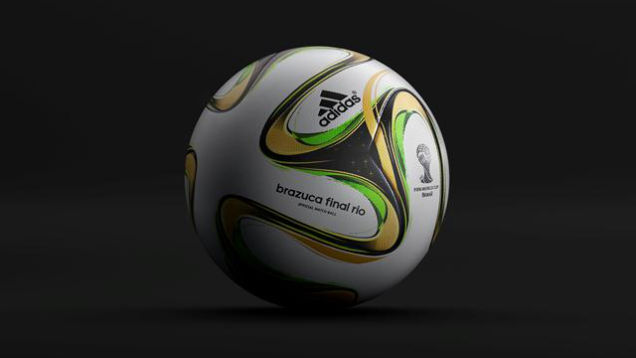Adidas's New World Cup Ball is The Fastest and Most Aerodynamic Ball Ever [VIDEO]
2014.06.03

Adidas will be supplying the balls for the 2014 World Cup and it will be the fastest and most aerodynamic one ever. The ball is called Brazuca, and here's what makes it unique:
1. The ball has a never before seen panel shape that produces faster flight speed.
2. The panels are bonded to keep the ball the same weight and roundness in even the thickest of rain.
3. The bladder is made of latex providing a desired rebound.
4, It is the most colorful world cup ball ever too.
Check out a video of it:
Japanese researcher Sungchan Hong decided to test the ball in wind tunnel tests and a kick-robot to examine the relationship between the panel shape and orientation of modern footballs. According to Tim Newcomb from Popular Mechanics who summarizes:
Hong says the new ball has a "stable flight trajectory thanks to the shape and number of panels that it is constructed from." The characteristics of the panels on a soccer ball have a "substantial impact on how the ball travels through the air," Hong says.
Hong and Takeshi Asai tested the balls by mounting them in a wind tunnel to test aerodynamic properties. They also used robots to kick the ball toward a goal 25 meters away and measure ball rotations, final impact point, and trajectories. Curiously, while Adidas has been steadily reducing the number of panels over the years, the scientists found that less isn't always more. While the six-panel Brazuca was the best performer, a conventional 32-panel ball followed it closely, the study says. Adidas is happy to forget the eight-panel knuckling Jabulani from the 2010 World Cup in South Africa—goalkeepers decried its fluttering and strikers lamented its inconsistency.
The Brazuca and the 32-panel ball had "relatively stable" data, whereas other balls in the study differed greatly based on how the ball's panels were facing prior to the robot's impact. "The changes in the flight characteristics (points of impact) of Cafus and Teamgeist 2 with the panel orientation were particularly drastic, which indicated that their panel orientation significantly affected their flight characteristics," the researchers say.
How will this affect the game and will players be able to maintain the same amount of ball control? Will goalies be able to block shots off properly? Hong and Takeshi Asai tested the balls by mounting them in a wind tunnel to test aerodynamic properties. They also used robots to kick the ball toward a goal 25 meters away and measure ball rotations, final impact point, and trajectories. Curiously, while Adidas has been steadily reducing the number of panels over the years, the scientists found that less isn't always more. While the six-panel Brazuca was the best performer, a conventional 32-panel ball followed it closely, the study says. Adidas is happy to forget the eight-panel knuckling Jabulani from the 2010 World Cup in South Africa—goalkeepers decried its fluttering and strikers lamented its inconsistency.
The Brazuca and the 32-panel ball had "relatively stable" data, whereas other balls in the study differed greatly based on how the ball's panels were facing prior to the robot's impact. "The changes in the flight characteristics (points of impact) of Cafus and Teamgeist 2 with the panel orientation were particularly drastic, which indicated that their panel orientation significantly affected their flight characteristics," the researchers say.
More Articles
Copyright © Fooyoh.com All rights reserved.